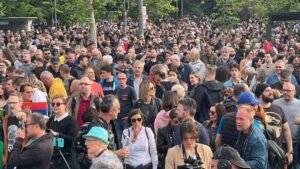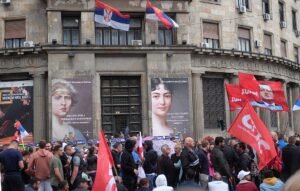Anti-government protesters gathered in thousands in Belgrade on Sunday to protest the results of the Serbian general elections, which they deem ‘unjust’. The protests have since escalated and turned aggressive.
Why did the election results trigger protests?
President Vucic of the Serbian Progressive Party called a snap election and won over 47% of the votes sealing the decade long grip of power on the nation and leading to a breakout of protests.
The international monitoring mission has also made accusations that the elections were symptomatic of voter coercion, vote buying and media bias rendering the results “unjust.”
A recently established opposition coalition called Serbia against Violence, which stands center-left, has also made claims that President Vucic committed election theft. Serbia against Violence came into being this summer post anti-government protests. It secured 23.56% votes in the election, while the Socialist Party secured 6.56%.
Marinika Terpic from Serbia Against Violence has been on a hunger strike since the elections to demand annulment.
The OSCE Office for Democratic Institutions and Human Rights has said the election day had been “marked by numerous procedural deficiencies.” The German Foreign Office also said the findings were “unacceptable for a country with EU candidate status.” Serbia has been looking to get membership in the EU while maintaining close Russian ties. Despite being in the running for EU status, Serbia has resisted sanctions on Russia.

Source: NATO via Flickr
The trajectory of the Protests in Belgrade and Serbia since May
In May 2023, mass protests, named “Serbia against Violence,” broke out in Belgrade and across Serbia following a school shooting in Belgrade and a spree shooting near Mladenovac and Smederevo. Tens of thousands of demonstrators participated in the protests, which began on May 8. They have been protesting on and off for various issues since the summer.

This time, however, the protests were triggered by the election results. They turned aggressive when the protesters began to storm city hall and use rocks and flagpoles to break into the building. The police, in turn, retaliated by using tear gas and riot shields. At least 38 protesters have been detained since Sunday in the protests that have been going on for over a week.
The opposition leaders, Srdjan Milivojevic and Vladimir Obradovic, attempted to open the door to a building during the protests. The police responded by using pepper spray to repel the protesters and prevent their entry. The incident reflects the rising tension in the already contentious atmosphere between the opposition leaders and law enforcement during the demonstration.
On Monday, thousands of protesters gathered around Belgrade’s central election commission building to continue the protest. The protesters have since marched to the main police station to object to the detention of the 38 detainees. In addition, eight policemen have been injured in the tussle.
Ivica Ivkovic, the head of the police administration, announced that two out of the eight injured policemen during the recent protests sustained serious injuries.
He states that the police will continue their commitment to preserving peace and order, that efforts will persist, and that more arrests related to the protests are anticipated. Ivkovic made these remarks during a news conference.
What has been President Vucic’s response to the ongoing protests?
Vucic characterized the protesters in May as “hyenas and vultures” and has accused the opposition of attempting to orchestrate a coup detat.

In response to the ongoing protests, President Vucic has assured the nation in a Sunday evening address that no revolution was taking place. He urged Serbs not to worry while expressing with confidence that the protests would not achieve anything significant. Vucic has called for a peaceful and mild response and emphasized that harm should be avoided to any random demonstrators.










